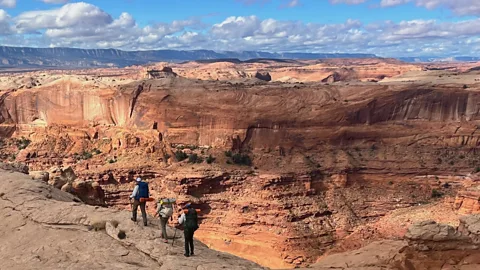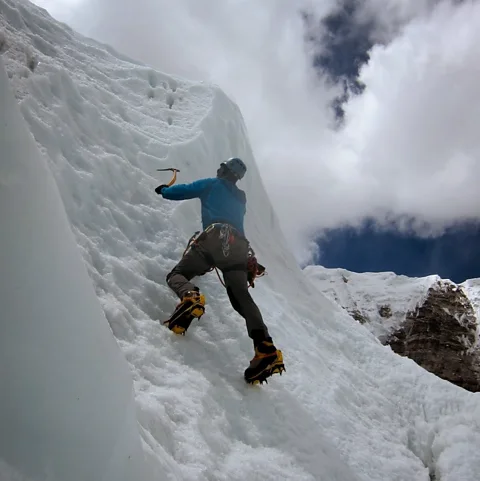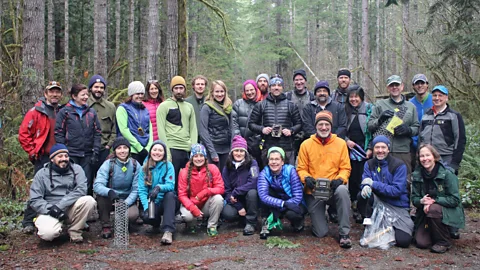The mountaineers and hikers collecting data in extreme environments that scientists can't reach
 Hari Mix
Hari MixCollecting data from the most extreme places on Earth can require the skills of the most extreme outdoor enthusiasts.
Surrounded by glaciers and roughly 6,400m (21,000ft) above sea level, Willie Benegas spotted a pop of green moss wedged in granite. "Wow, this is an odd place for moss to be," he observed.
In 2011, Benegas, an extreme mountaineering guide, was 500ft (152m) above the steep, exposed terrain of Mount Everest's Camp 2 and – despite having summited Mount Everest over a dozen times – he still found himself "impressed". Using a sterilised cloth Benegas scooped the moss into an envelope to be transported to a lab on another continent.
The moss travelled from the planet's peak to Montana State University's Department of Microbiology and Cell Biology, where Tim McDermott, an environmental microbiologist, analysed the bacteria living on its surface. From there, the moss continued to Rusty Rodriguez, a microbiologist for the United States Geological Survey, who was researching how plants form symbiotic relationships with fungi that can help them survive extreme conditions. His research revealed that these fungi can programme plants to withstand drought and temperature stress.
As plant life expands to ever-higher altitudes, it was hoped this moss could reveal how crops can adapt to increasingly extreme weather, withstanding frost and high ultraviolet (UV) radiation. The findings were later used to increase crop yields around the world – and Rodriguez developed a Seattle-based company, Adaptive Symbiotic Technologies (AST). AST manufactures fungal spores to enhance crop tolerance to extreme weather. Without the help of mountaineers and volunteers, says Rodriguez, this would not have been possible.
 Adventure Scientists
Adventure ScientistsBenegas collected the moss samples for the non-profit Adventure Scientists, which acts as a matchmaking service between outdoor enthusiasts and scientists. "Scientists like to have samples taken in locations where it's difficult – sometimes damn near impossible – to get funding [to go]," McDermott says. "I was flabbergasted [Adventure Scientists] were even willing to try."
Gregg Treinish founded Adventure Scientists in 2011 after spending 22 months hiking the Andes, a trip which earned him and his partner Deia Schlosberg the title of National Geographic's Adventurers of the Year in 2008. An outdoorsman for years, Treinish hiked the Appalachian Trail in 2004 and felt a deep sense of selfishness in the awe-inspiring terrain of the Eastern United States.
Treinish discovered his hiking-related guilt rendered him in good company. While contact with nature is linked to psychological well-being, the juxtaposition with climate anxiety can make enjoying the outdoors complicated. New terms like eco-grief, Anthropocene horror and solastalgia are emotional epithets of environmental woes.
"Climbing is selfish," says Hari Mix, a mountain climber who collected data for Adventure Scientists during his Himalayan expeditions in 2012 and 2013. "There's no real point to it. I was looking for ways to add meaning or some kind of contribution to my trips."
 Hari Mix
Hari MixAdventure Scientists, which targets the UN Sustainable Development Goals, partners with scientists – typically from universities and non-governmental organisations (NGOs) – who need data to address environmental issues. The non-profit trains and manages volunteers to collect remote data as a cost-effective accelerator for conservation solutions around the world. Adventure Scientists has had more than 10,000 trained volunteers gather data for more than 120 partners. "Countless people love the outdoors and wish they could make a difference," says Treinish. "If we could galvanise them in a common direction, what we could achieve would be profound."
Adventure Scientists exists within the growing ecosystem of community science, also known as citizen science, which allows people of all backgrounds and ages to collect data and contribute to scientific research. Volunteer opportunities range from collecting data for public sector organisations like the National Oceanic and Atmospheric Administration or Nasa, to helping private organisations like Advancing Participatory Sciences which connects researchers and citizen scientists.
Though many view science as a specialised enterprise, Treinish simply describes science as a "process of inquiry". "By academic standards, I am not a scientist," acknowledges Treinish. And, according to an expert from the United Nations, science should not be exclusively for scientists.
The strength of Adventure Scientists lies in its ability to mobilise many people, says USDA Forest Service wildlife biologist Betsy Howell. In 2012, Howell partnered with Adventure Scientists in Washington State, US, to understand the conservation status of martens with the first winter of surveys starting in January 2013. There had been only six verifiable marten sightings since 1968, she explains.
 Kyle Noble
Kyle Noble"Martens are important members of the community but were, as far as anybody could tell, gone from the entire state," says Howell. So local volunteers, lugging motion-activated digital cameras and bait, descended on the remote, rugged, snowy terrain of the Olympic National Forest.
"People had to ski or snowshoe in," says Howell. "It can be extremely difficult to get around." After the volunteers hiked through the backcountry to install cameras, they returned to check the footage for martens. That survey did not document any Pacific martens. Still, Howell maintained that the efforts with Adventure Scientists in 2013 and 2014 were useful, as they highlighted the challenges of finding the animals.
"After I worked with Gregg and the team – and because of their work – we were able to apply for some special money and hire crews devoted solely to marten survey work to move them up in elevation even more. [We] got into even more remote areas and then finally started to get some marten hits," Howell adds, noting subsequent survey efforts from 2015 to 2019.
In Washington State, John Soltys, a long-time volunteer for Adventure Scientists, says data collection bestows a sense of "purpose" on his family's alfresco activities. Soltys stumbled upon Adventure Scientists in 2013 while on a camping trip to Berkeley Park in Mount Rainier National Park, Washington State. Soltys's young children became "absolutely mesmerised" by the scurrying pikas – mountain-dwelling, mouse-like mammals. Soltys scoured iNaturalist, a social network for sharing biodiversity finds. There, he found Adventure Scientists, which was also utilising the platform to collect data on pikas. His family now volunteers with the nonprofit 100 times a year, he says. "Yeah, we're doing that crazy stuff," he says.
![Shemuel Harding "[We] got into even more remote areas and then finally started to get some marten hits," says Betsy Howell (Credit: Shemuel Harding)](https://ichef.bbci.co.uk/images/ic/480xn/p0k41nbd.jpg.webp) Shemuel Harding
Shemuel HardingSoltys and his family also work with Community Snow Observations, Living Snow Project and Cascades Carnivore Project to foster a love for the outdoors and environmental stewardship. Soltys' daughter even went on to pursue a degree in environmental science at the University of Washington due to these experiences, he adds.
Expertise and grassroots science can coexist, posits Treinish. No doubt, researchers with specific areas of expertise are necessary. Even a former member of Adventure Scientists' scientific advisory board, McDermott, acknowledged these "off the beaten path" samplings that private citizens can obtain are limited in sophistication. But adventuresome generalists, who are keen to get their hands dirty, can aid in furthering human understanding of the natural world. "If you're going to go to extreme lengths, why not make it useful?" asked Treinish.
"Whenever the global scientific community thinks about addressing an issue with boots on the ground, I hope they think about the solutions without a limit to data," says Treinish. "It's at our fingertips. We've got one chance, and we better make the most of it."
—
If you liked this story, sign up for The Essential List newsletter – a handpicked selection of features, videos and can't-miss news, delivered to your inbox twice a week
